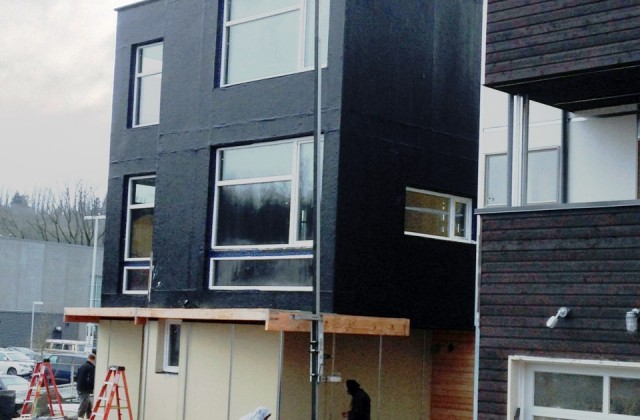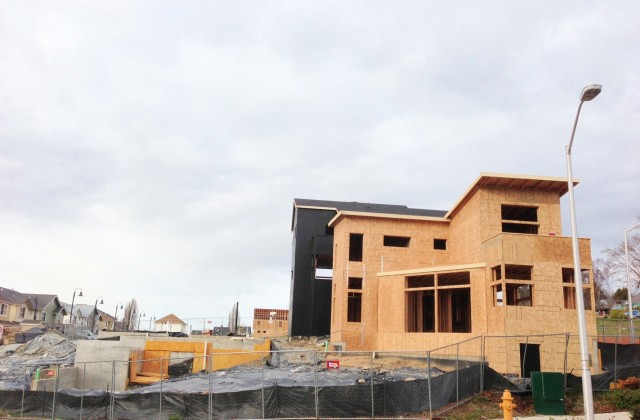Smart Growth on the Seattle Channel
Last week I had the opportunity to represent Smart Growth Seattle on a panel discussing development on small-lots in Seattle. The panel is part of a broader discussion on density and you can watch it by clicking on the embedded video above.
The panel covered a lot of ground, but what was especially important is that we spent some time clarifying our initiative, changing the code to create the 80 percent rule. What’s really positive here is that our proposal is being considered and discussed now, during the early phases of the development of legislation.
We still have weeks and months of discussion ahead, but the conversation is going in the best direction it possibly could: how do we create predictable rules for infill development in single-family neighborhoods? That’s exactly what the 80 percent rule would do, allowing everyone to have a set of standards that allow new homes and appropriate scale.
Councilmembers on the Planning, Land Use, and Sustainability (PLUS) committee still need to hear from you about your thoughts.
Chair: Richard Conlin
Vice-Chair: Tim Burgess
Member: Mike O’Brien
Alternate: Sally J. Clark
Work in Progress: First Look at Small Lot Recommendations
Last week the City Council’s Planning, Land Use, and Sustainability (PLUS) Committee met and heard recommendations about finalizing small-lot legislation. The memo issued by the Department of Planning and Development included important elements of our initiative to support the 80 percent rule, allowing development on lots slightly smaller than the average lot on a block.
It is still early in the process. Your input has helped. We hope you’ll continue to send e-mails encouraging the Council to support more housing options as Seattle grows. Here is the initial response we sent to the PLUS committee yesterday. Let us know your thoughts and let the Council know your thoughts as well.
1. Set a uniform absolute minimum lot area of 2,000 square feet, to apply to lots qualifying under all lot area exceptions.
We expect a minimum lot size in the proposed legislation and think 2000 square feet is reasonable. We’d also appreciate a discussion of the importance of the legal standing of a property in determining whether it should be developed. Limitations on development based only on lot size will limit some important opportunities to build energy efficient, affordable, and neighborhood scale housing.
We also believe two-house/one lot short plats show historical intent and should be allowed because they don’t change the current uses of the property. As such, we would not support the removal of exemptions for these from the proposed legislation.
2. Limit structure height permitted outright on lots under 3,200 square feet in area to 18 feet, plus a five-foot pitched roof.
We suggest that you keep the interim standard of 22 feet rather than 18 since the code determines height based on the existing grade at the midpoint of each side of the building to the top plate for pitched roofs, or the top of roof structure for flat roofs.
As a practical matter, an 18-foot height limit for a flat roof home makes it difficult to get two full floors without depressing the home into the ground.
A compromise would be 22 feet without the 5-foot additional for pitched roofs and/or 18 feet with the extra 5 feet to ridge as has been proposed on pitched roofs. Without this compromise, an 18-foot height limit would limit many lots to 1-story, which doesn’t appear to be Council’s or DPD’s intent.
3. Allow additional height on lots under 3,200 square feet in area as a special exception, a Type II decision.
This recommendation is fine, provided that the height limit remain at 22 feet, as it is in the interim standard.
4. Limit the ability for multiple, abutting undersized lots to qualify for separate development under the exception provided for lots established by pre-1957 records.
If we understand this correctly, ownership of two adjacent undersized lots would require consolidation of those lots. If that’s the case, we think this provision would be unfair to property owners who have two small pre-existing lots. That owner would end up with one large lot, something inconsistent with the stated intention of the DPD recommendations to encourage building smaller infill homes.
5. Continue the limitation established under the interim ordinance, not allowing undersized lots to qualify for a lot area exception based on historic tax records, and also disallow qualification based on mortgage records.
Provided that the Council adopts the 80 percent rule proposal, we will support recommendation to disallow development on lots excepted based on historic tax records. However, many of our members still feel strongly that for many years exemptions to lot size have been based on legal intent “by deed, contract of sale, mortgage, property tax segregation, platting, or building permit.”
Smart Growth Seattle will not support a limitation on mortgage records since it represents the clear legal intent of a property owner to preserve development potential on part of their property.
The proposed legislation to end exemptions based on historic tax records will reduce housing supply by about 18 to 24 homes per year. We believe that loss can be mitigated by adoption of the new 80 percent rule and result in more predictable neighborhood scale development.
6. Alternative to the 75/80 Rule
The 2000-foot minimum is acceptable as mentioned above. Application of the Type II decision requirement should apply but only when height exceeds 22 feet.
It is unclear what is intended by preventing the demolition of existing houses. We don’t believe that the Council would intend to eliminate demolition of a home if a property owner desired to rebuild, so it isn’t clear how this prohibition would be implemented.
Limiting the application of the rule to urban centers or transit areas seems counterproductive since most single-family neighborhoods where these rules would apply are substantially outside these areas.
7. A number of other minor amendments
We do not support the limitation of structure depth based on the width of lot frontage under 3200 square feet. The case for our opposition to this is made even stronger with 18-foot height limits since, if we lower height to 18 feet, development on a 25 x 100 foot lot (standard original Seattle platting size lot) would result in an 18 foot high, 1500 square foot house with garage. Excluding the garage, a home would end up with less than 1300 square feet of living space. We should allow existing requirements in the land use code to determine setback requirements, which will result in more housing choice.
More Jobs Means We Need More Housing
This Thursday the Seattle City Council’s Planning Land Use and Sustainability (PLUS) Committee will meet to hear recommendations about how to finalize last year’s emergency small-lot legislation. The Department of Planning and Development will present several months worth of work on moving ahead on legislation. One important point that needs to be made in these discussions is the effect job creation has on housing price and how allowing single-family home construction can help make Seattle affordable.
Over at Seattle Bubble, Tim Ellis does a great job of summing up first quarter reports on housing supply and price in Seattle and the region. Housing prices are going up and Ellis quotes J. Lennox Scott, chairman and CEO of John L. Scott, Inc., who says that he “attributes surging sales and prices to several factors, including positive job growth, historically low interest rates and fewer homes being listed.”
Supply of new homes isn’t keeping up with demand, and that certainly will lead to higher prices. Other factors cited by Sanjay Bhatt in his article quoted by Ellis are:
Some sellers are waiting for prices to climb higher before listing their homes. Others still owe more on their homes than they’re worth.
A third group of sellers is unwilling to interrupt the cash flow they receive from renting out their homes at high rates.
But more jobs are coming. The Business Insider says that Amazon is going on a “hiring binge,” as it ramps up its sales force. New jobs are great news for the ailing economy, but with low inventories where will new workers relocating to Seattle live? The good news about more jobs might end up blunted by low housing supply that could lead to surging prices.
The City Council continues to put its attention on what it calls “workforce” housing, units of rental housing priced at 60 to 80 percent of Area Median Income. The truth is that the market is already producing lots of rental housing at this price point. Small, affordable apartments are the most obvious example. Keeping that choice for new workers is going to be an important part of Seattle’s housing solution.
But many of the new workers will want a detached single-family home. The conventional wisdom is that new single-family homes are very expensive in Seattle, even smaller more energy efficient homes. Some argue that single-family homes are beyond the reach of most young, new workers.
While a new single-family home priced at $665,000, for example, might seem out of reach, let’s think it through for a moment.
House Price: $665,000
Loan: $562,500 (10 percent down, 30 years)
Monthly Payment: $ 3,176
For a home at this price, a family with a household income of about $125,000 would be paying roughly 30 percent of their monthly income on housing costs. Not every household earns this kind of money, but many professionals moving into the city to work at Amazon will have two median level incomes (Real Area Median Income in Seattle is about $64,000 per year) could afford a new single-family home at this price.
And as I pointed out last week, a Passive House designed by Dwell, sold for about $100,000 less than this hypothetical $665,000. That’s an innovative, super energy efficient house that under the same loan scenario described above, would be even more affordable.
Seattle needs a strong supply of housing priced for people who earn a lot less than Real Area Median Income, and often that housing needs subsidy from grants, low interest bonds, and tax credits. But the market, if it’s allowed to, can also provide choices—and home ownership—for people who earn median incomes. And just as important these homes should be in Seattle where access to transit and jobs makes living here more sustainable than in suburban sprawl. Let the Council know what you think.
| WHEN | Thursday, March 14, 2013, 9:30 a.m. | |||
| ADDRESS | Council Chambers Seattle City Hall, Floor 2 600 Fourth Avenue Seattle |
|||
| CONTACT | Richard Conlin, Chair richard.conlin@seattle.gov 206-684-8805 |
|||
| ADDITIONAL INFORMATION | Visiting City Hall | |||
Passive House: Innovative and Affordable
Last week I had a chance to take a tour of Dwell Development’s Passive House at Columbia Station, near the Columbia City light rail station. Passive house (or Passivhaus) is a concept that I described in an article I wrote for Sustainable Industries a few years ago. Here’s what I wrote then:
Passivhaus buildings have:
- A super-insulated envelope (in our climate, perhaps an R-48 wall, R60 roof);
- High-performance triple-glazed windows (U-value .15 or lower);
- Reduction or elimination of thermal bridging;
- Super airtight construction (has to meet Air Change Rate of .6 ACH @ 50 Pascals, almost unheard of, and probably the hardest part of building a passive house);
- Heat-recovery ventilation; and
- Use of passive sources for heat gain – solar of course, but also lighting, appliances and even people in the building.
Passivhaus design takes advantage of materials to dramatically limit total energy consumption by reducing the need for heating and cooling. It’s ‘passive’ because keeping a building warm or cool doesn’t require flipping a switch or adjusting a thermostat. In other words, it’s self-regulating. The building—because of materials and design—retains heat when it’s needed most without the need to heat up cold air and move it around.
Building a Passive House is a complex undertaking and includes many custom-built and hard to find materials. The windows, for example, are pricey and have to be ordered from a manufacturer in Lithuania. You’d think that a Passive House would be very expensive—but compared to the other homes around it, the Passive House is not expensive at all.
In fact, Dwell’s product at Columbia Station ranges from the high $300,000 range to the low $500,000 range. For a dual income couple earning a combined income of $150,000 the mortgage on any of these homes—including the Passive House—would be 30 percent of their monthly income or less. And that doesn’t take into consideration the energy savings built into all of Dwell’s homes. Passive Houses typically deliver as much as 90 percent savings on energy over regular houses.
For more on Dwell’s projects and for a great video series on the Passive House check out their website and stop by the project at Columbia Station project.
City Builders Happy Hour is a Year Old!
It may seem a bit silly to make a fuss over an every-once-and-awhile happy hour. But the City Builder Happy Hour is something a little bit different. Part networking session and part idea incubator, the City Builder Happy has hosted several fun and engaging evenings of idea sharing and catching up on local land use and politics.
I presented the idea of neighborhood scaled Real Estate Investment Trusts (REITs) as way of stemming the NIMBY tide against new development. And other ideas have surfaced over the last year too like a gondola for Seattle. Generally, City Builders has been about multifamily development, but it’s also been a forum of the importance of other parts of making Seattle a dense, livable, and walkable city.
If you have time stop by to talk about anything you want, but we’d also like to have you attend to share your support of our efforts to support housing choices in all of Seattle’s neighborhoods.
Here’s the details:
2013 City Builder Happy Hour
Thursday, February 28 at 5:30 at
Pike Brewing Company
5:30 PM
1415 First Avenue in the Pike Place Market.
There is no cost to attend a City Builder Happy Hour.
Also become a member of the City Builder group on Facebook.




